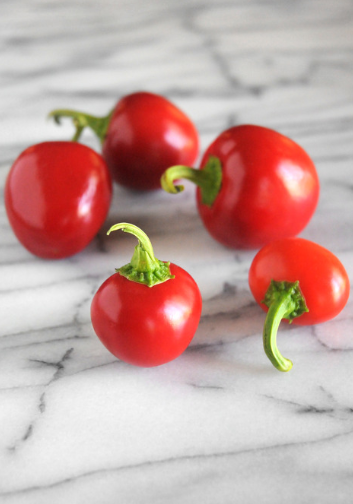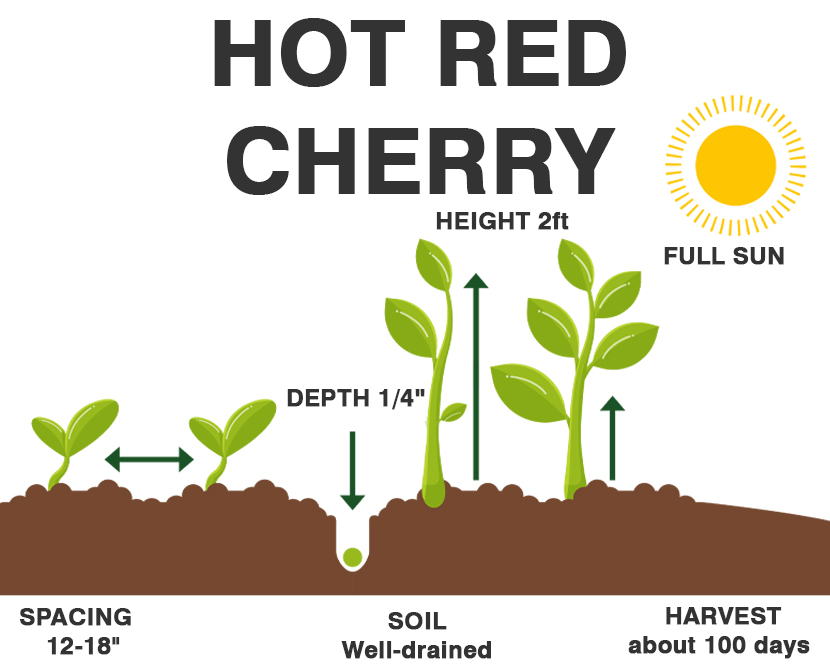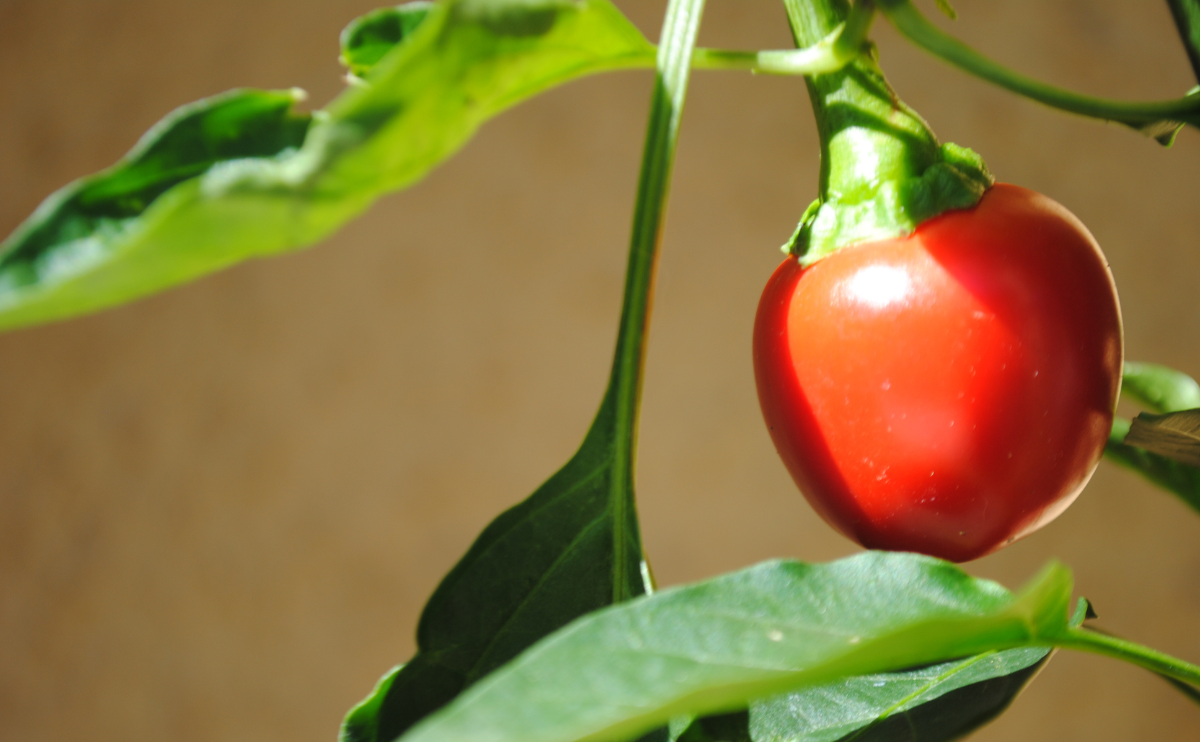Red Cherry chile peppers, botanically classified as Capsicum annuum, are small, uniquely shaped pods that belong to the Solanaceae or nightshade family. Also known as the Hungarian Cherry pepper, Cherry Bomb pepper, and Sweet Cherry chile pepper, Red Cherry chile peppers are named after their resemblance in size and shape to cherries and cherry tomatoes. There are two main types of Red Cherry chile peppers including sweet peppers, which range 100-3,500 SHU and hot peppers, which range 2,500-5,000 SHU on the Scoville scale. The two main types are difficult to distinguish by appearance alone, and even homegrown plants may vary in spice levels depending on the climate and soil it is grown in. Both kinds of Red Cherry chile peppers have thick flesh and are popularly pickled for commercial use, often found preserved in glass jars at supermarkets and specialty grocers.

| Common Name | Red Cherry chile pepper |
| Botanical Name | Capsicum annuum |
| Family | Solanaceae |
| Plant Type | Perennial, vegetable |
| Size | 1–4 ft. tall, 1–2 ft. wide |
| Sun Exposure | Full sun |
| Soil Type | Moist, well-drained |
| Soil pH | Acidic, neutral |
| Bloom Time | Summer |
| Hardiness Zones | 9–11 (USDA) |

When to Plant?
This will be determined by your planting zone. There is a final frost date for each area. As a result, you can plan your gardening activities around this date. Check our Frost Dates Across North America: First & Last Frost Dates Chart. However, the date will not be the same for every plant.
How to Plant
Only home gardeners who enjoy long growing seasons in the Deep South should attempt to sow pepper seeds directly in the vegetable garden. Most of us must start our own pepper plants indoors about 8-10 weeks before transplanting, which should be done 2-3 weeks after the expected last frost.
As soon as seedlings emerge, provide plenty of light on a sunny windowsill or grow seedlings 3-4 inches beneath fluorescent plant lights turned on 16 hours per day, off for 8 hours at night. Raise the lights as the plants grow taller. Incandescent bulbs will not work for this process because they will get too hot. Most plants require a dark period to grow, do not leave lights on for 24 hours.

Seedlings do not need much fertilizer, feed when they are 3-4 weeks old using a starter solution (half strength of a complete indoor houseplant food) according to manufacturer’s directions.
If you are growing in small cells, you may need to transplant the seedlings to 3 or 4-inch pots when seedlings have at least 3 pairs of leaves before transplanting to the garden so they have enough room to develop strong roots
Before planting in the garden, seedling plants need to be “hardened off”. Accustom young plants to outdoor conditions by moving them to a sheltered place outside for a week. Be sure to protect them from wind and hot sun at first. If frost threatens at night, cover or brings containers indoors, then take them out again in the morning. This hardening off process toughens the plant’s cell structure and reduces transplant shock and scalding.
How to Cultivate
Keep weeds under control during the growing season. Weeds compete with plants for water, space and nutrients, so control them by either cultivating often or using a mulch to prevent their seeds from germinating.
Mulches also help retain soil moisture and maintain even soil temperatures. This is especially significant for peppers, as their roots may be easily damaged when weeding, and this can lead to blossom end rot.
Keep plants well-watered during the growing season, especially during dry spells. Plants need about 1-2″ of rain per week during the growing season. Use a rain gauge to check to see if you need to add water. It’s best to water with a drip or trickle system that delivers water at low pressure at the soil level. If you water with overhead sprinklers, water early in the day so the foliage has time to dry off before evening, to minimize disease problems. Keep the soil moist but not saturated.
Note that hot peppers tend to be hotter when they have less water and fertilizer. If they receive plenty of water and fertilizer, they may be milder than expected. Monitor for pests and diseases. Check with your local Cooperative Extension Service for pest controls recommended for your area.
Try planting pepper plants near tomatoes, parsley, basil, and carrots in your home vegetable garden. Don’t plant them near fennel or kohlrabi. Peppers are very colorful when in full fruit and combine well with green herbs, okra, beans and cucumber fences in the garden bed.
How to Harvest
To harvest red hot cherry peppers, use kitchen or garden shears or snippers. Tugging at the fruit can damage the entire plant, so use the scissors to cut the stem about 1 inch above the place where the stem is attached to the pepper.
Hydroponics
Germination: Start by soaking the seeds in water for a few hours to soften the seed coat. Then, place them in a damp paper towel and keep them in a warm, dark place for a few days until they germinate. Once the seeds have sprouted, you can plant them in your hydroponic system.
pH range: The optimal pH range for Hot Red Cherry peppers is between 5.5 and 6.5. It’s essential to maintain this pH range to ensure that the plant can absorb the necessary nutrients effectively.
EC: The electrical conductivity (EC) range for Hot Red Cherry peppers is between 1.5 and 2.5 mS/cm.
PPM: The recommended parts per million (PPM) for Hot Red Cherry peppers is between 840 and 1260. Ensure that your nutrient solution stays within this range to avoid over-fertilizing or under-fertilizing the plants.
Humidity: Hot Red Cherry peppers prefer a humidity level of around 60-70%. It’s essential to maintain the proper humidity level to prevent the plants from drying out or becoming too wet.
Light hours: Hot Red Cherry peppers require around 12-16 hours of light per day. Use grow lights or natural sunlight to provide the necessary light for your plants.
Temperature air: The ideal temperature range for Hot Red Cherry peppers is between 21-29°C (70-85°F) during the day and 18-21°C (65-70°F) at night.
Temperature water: The optimal water temperature range for Hot Red Cherry peppers is between 20-23°C (68-73°F). Avoid using water that’s too cold or too hot, as it can shock the plants and slow their growth.
With these guidelines, you should be able to grow healthy plants hydroponically. Good luck, and happy growing!



